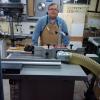
Originally Posted by
Tony Pisano

Give me good old imperial. I can't think or visualize in metric. I know in my head that 7/16 is .437 and I looked it up in metric and its 11.1125. How is that any easier? If you tell me to take 5 or 10 thousanths off of something, I understand how much that is and can do it. Tell me to make it 3 millimeters, or go about half a kilometer and take a left, or the temperature is 40 degrees centigrade, or something weighs 5 kilograms, and I just stand there and scratch my head!





 Reply With Quote
Reply With Quote





